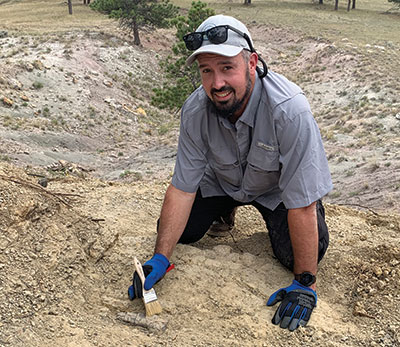 ICR conducted its first paleontological excavation on September 4-5, 2021. Last years’ inspection of a site on private property in Wyoming concluded that bone material partly exposed from a Morrison Formation outcrop might indicate a dig site. This years’ pilot excavation tested the feasibility of conducting regular digs there. They would fulfill at least two purposes.
ICR conducted its first paleontological excavation on September 4-5, 2021. Last years’ inspection of a site on private property in Wyoming concluded that bone material partly exposed from a Morrison Formation outcrop might indicate a dig site. This years’ pilot excavation tested the feasibility of conducting regular digs there. They would fulfill at least two purposes.

One purpose for conducting an annual dig has more to do with relationships than with science. There’s nothing like sharing the experiences of sleeping and eating outdoors and working with a team that intends to uncover buried bone. Being with folks who are enthusiastic about ways that these fossils confirm Noah’s Flood builds unity.
To actually find and extract bone fossils comes as a bonus! Blessings from this year’s brief dig included half a sauropod femur and what looks like the tip of a Camarasaurus tooth. Further investigation may reveal that the two specimens belong to the same carcass. The rough facilities and small dig area would limit future excavations to a few hardy participants who could share thrills of discovery that strengthen lifelong friendships.

Another purpose for conducting annual digs is to collect and catalogue specimens. We could display them in the ICR Discovery Center for Science & Earth History. Even better, we might display evidence of original organics (such as proteins) if we can find it.
Why? In short, measured decay rates show protein should not last a million years. The presence of proteins already confirmed in many fossils thus aligns with the Flood, which deposited these sediments with their plant and animal remains only thousands of years ago. This was the subject of my Ph.D. thesis, which ICR has made available.1 Large-diameter bones are more likely to contain protein remnants, and few bones grew bigger than sauropod femora.

Before we can look for proteins or display a bone, we first have to obtain it. The Lord blessed our excavation with a good first step. Now we must trust Him to lead us in building relationships and conducting science that honor Him.
Reference
- Thomas, B. 2019. Ancient and Fossil Bone Collagen Remnants. Dallas, TX: Institute for Creation Research. Available at store.ICR.org.
* Dr. Thomas is Research Scientist at the Institute for Creation Research and earned his Ph.D. in paleobiochemistry from the University of Liverpool.




